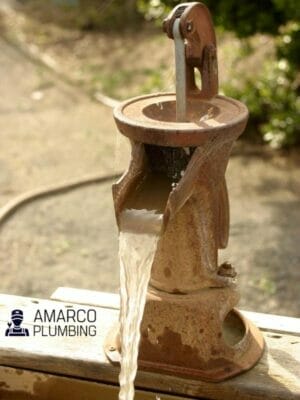Disclaimer: This post may contain affiliate links, meaning we get a small commission if you make a purchase through our links, at no cost to you. For more information, please visit our Disclaimer Page.
Normally, well water should be clear and colorless. Sometimes, the water often gives different colors, such as red, green, or milky-white (cloudy). If the water is appearing cloudy, this could be air trapped in your water supply. Also it can be a sign that silt is present in the water supply.

Table of Contents
What does it mean when well water is cloudy?
A well is a hole drilled into the ground to reach the aquifers, a body of rock that holds groundwater. According to the EPA, more than 13 million households across different states in the United States use private well water for drinking. Domestic well water is pretty cheap and saves people the stress and money to pay for the local water supply.
However, you need to understand that well water also has its setbacks. One of them is that we’ll water can be affected by contamination. This is usually a result of the area where the well is located.
Apart from being contaminated, well water also tends to change color in certain situations. Most times, the discoloration of well water is usually caused by the penetration of unsafe water into your domestic well system.
As you already know, a properly drilled well should deliver clean and colorless water. However, as soon as unsafe water starts to enter the well, the colorless groundwater begins to display various colors.
Well water discoloration issues
Green/blue is one of the many colors that contaminated well water could produce. If this is what you’re currently experiencing, then you need to understand that this is a warning sign that your copper pipes are corroded.
Apart from appearing green or blue, other colors that your well water could take when it’s contaminated are brown, red, orange, or yellow. If this is what you’re currently encountering, then you need to understand that this could be a warning sign that one or more of your pipes (steel, galvanized iron, or cast iron) are rusty.
Dark brown is another color that your well water could produce when it’s contaminated. In this case, this could mean that there’s an excessive amount of manganese in your water supply.
Here’s what you need to know about cloudy well water
In addition to the colors listed above, another common color that contaminated well water could give is milky-white (cloudy). If this is what you’re currently facing, you need to stop worrying too much about it.
A cloudy or milky white color is simply indicating that tiny bubbles of air are trapped inside the water supply. That’s not all; having cloudy well water could also be a warning sign that the groundwater contains silt or other sediments.
Bottom line: if your well water is cloudy, this could be a warning sign that air is likely trapped inside your water supply. By leaving the water for a few minutes, it should clear out on its own.
Why is my well water cloudy?
As earlier mentioned, the primary cause of cloudy well water is air bubbles getting trapped in your water supply. Apart from that, a couple of other factors that could make your well water cloudy. Let’s have a look at all of them below:
Air bubbles
The presence of air bubbles in water is, no doubt, one of the common causes of cloudy well water. Unfortunately, this could happen in different ways.
For instance, if the water level in your well is pretty low, it’s likely to have your pumping device pump a mix of air and water. If this happens, it could make your well water appear cloudy. In this case, the best you can do is to reduce the amount of water you pump from the well.
According to USGS, cold weather is another factor that could introduce air bubbles to your water supply. When it’s cold outside, any water under a lot of pressure tends to attract more air in the form of a solution. This is another explanation for why your well water is cloudy or milky-white.
Presence of sediment in your water supply
Another reason why your well water could appear cloudy is that there’s a high level of sediment in your water supply. The best way to test for that is by fetching the cloudy water inside a glass cup and leaving it for a couple of hours to settle down.
After that, check the bottom of the glass cup for traces of debris – if you can find any, it means the cloudy water issue is a result of the high level of sediment in your water supply. In this situation, all you need is to speak with your domestic water well technician to help you check and see why there’s excess sediment in your water supply.
High level of manganese
The presence of a high level of manganese in your water supply could also make your well water appear milky-white. If this happens, your water will most likely give a metallic taste. The best way to address this issue is by performing chemical water treatment on your domestic water well.

Can heavy rain make private well water cloudy?
Heavy rain can always introduce various contaminants into your well, which could end up causing discoloration of the water. A couple of factors could make your well water cloudy after heavy rain; some of them include:
- Has your water been off for some time? If yes, you need to understand that rust and debris could be the cause of the cloudiness and not necessarily the rain itself.
- Runoff contamination, as a result of the heavy rain, could certainly make your water cloudy. The cloudy water is most likely appearing because contaminants in the rainwater have penetrated your private well.
The bottom line is that heavy downpour could make your domestic well water cloudy or milky-white. If that’s what you’re currently experiencing, then you need to understand that the presence of runoff contaminants in your water supply is the main culprit.
How do I fix my cloudy well water?
Sometimes, cloudy well water could be safe for drinking, depending on the cause of the issue. For instance, if the milkiness is caused by the presence of air bubbles, you can always drink the water as it’s safe. The best way to address the issue, in this case, is by leaving the water for some time to settle down.
As earlier mentioned, your pumping device could be the reason why air is being trapped in your water supply. This happens when there’s a low amount of water in your well. In this case, the best you can do is to reduce the rate at which your households depend on the well water.
Furthermore, if the cloudy well water is a result of runoff contaminant, the best solution is to contact a water well expert to help you test the water and perform the relevant chemical treatment.
